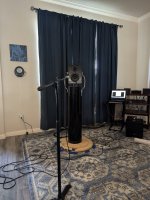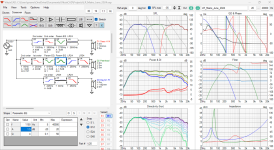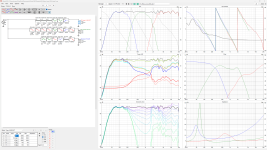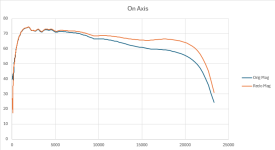Hello everybody. I was hoping for advice on a 3 way build I've been tinkering with for some time - everything from the basic concept to implementation details. So here goes!
General intro: this was supposed to be a riff on the LX-mini, just a bit muscled up. So it uses an 8" up-firing woofer (Dayton RS-225) in a sealed cylinder base, with a 5 1/4" open baffle midrange (Peerless NE-149) and a SEAS DXT tweeter (H1499) mounted together in a 9" x 12" panel suspended over the woofer. A miniDSP 10x10 box does XOs and PEQ.
The "interesting" directivity patterns this would generate were acknowledged going in. Maybe it's an inherently bad idea. I was drunk on inexperience and Linkwitz's website!
After blowing two $100 DXT tweeters in testing, I took to doing measurements with an LR4 at 2500 Hz in place. Which was my intended XO. But the freaky on- vs off-axis behavior of the NE149 right there (which looks worse in my measurements than the spec sheet - maybe baffle effects?) caused warts that made me want to move the XO lower and try to bury that. So the screenshot shows my hacky attempt at a simulated 1600 Hz crossover, using driver data that was already rolled off at 2500. The shorted 2500 filter block is in the schematic to remind me it's already present in the acoustic data. If need be, I guess I can really implement it like this! But that leads into the questions:
1. Will I tend to blow the DXT trying for a 1600 Hz crossover? (I see the power dissipation graph in V-CAD -- kilowatts, what? -- but would welcome real-world experiences....)
2. Given that it is what it is, physically, at this point - should I try to tune it for steady power in room rather than on-axis/listening window, by boosting the mid-range? "Just listen to it myself", of course. I will, when I think I won't pop more pricey tweeter voice coils. What do other people (expect they might) prefer?
3. Am I interpreting the situation right here, thinking that the directivity & DI plots shown are just inescapable features of this sealed-OB-sealed Frankentower? Previous versions had even-grosser directivity issues around the crossover region. But I think the current gross directivity issues are just the bed I have to lie in??
I initially just PEQ-ed the drivers to flat, slapped on LR4s at 300 and 2500 -- thought it sounded pretty good, and got on with life. But now I am trying to do a more proper development.
Any insights are much appreciated!
General intro: this was supposed to be a riff on the LX-mini, just a bit muscled up. So it uses an 8" up-firing woofer (Dayton RS-225) in a sealed cylinder base, with a 5 1/4" open baffle midrange (Peerless NE-149) and a SEAS DXT tweeter (H1499) mounted together in a 9" x 12" panel suspended over the woofer. A miniDSP 10x10 box does XOs and PEQ.
The "interesting" directivity patterns this would generate were acknowledged going in. Maybe it's an inherently bad idea. I was drunk on inexperience and Linkwitz's website!
After blowing two $100 DXT tweeters in testing, I took to doing measurements with an LR4 at 2500 Hz in place. Which was my intended XO. But the freaky on- vs off-axis behavior of the NE149 right there (which looks worse in my measurements than the spec sheet - maybe baffle effects?) caused warts that made me want to move the XO lower and try to bury that. So the screenshot shows my hacky attempt at a simulated 1600 Hz crossover, using driver data that was already rolled off at 2500. The shorted 2500 filter block is in the schematic to remind me it's already present in the acoustic data. If need be, I guess I can really implement it like this! But that leads into the questions:
1. Will I tend to blow the DXT trying for a 1600 Hz crossover? (I see the power dissipation graph in V-CAD -- kilowatts, what? -- but would welcome real-world experiences....)
2. Given that it is what it is, physically, at this point - should I try to tune it for steady power in room rather than on-axis/listening window, by boosting the mid-range? "Just listen to it myself", of course. I will, when I think I won't pop more pricey tweeter voice coils. What do other people (expect they might) prefer?
3. Am I interpreting the situation right here, thinking that the directivity & DI plots shown are just inescapable features of this sealed-OB-sealed Frankentower? Previous versions had even-grosser directivity issues around the crossover region. But I think the current gross directivity issues are just the bed I have to lie in??
I initially just PEQ-ed the drivers to flat, slapped on LR4s at 300 and 2500 -- thought it sounded pretty good, and got on with life. But now I am trying to do a more proper development.
Any insights are much appreciated!
Attachments
If you are destroying tweeters during testing, I think that indicates you need to refine your measurement techniques.
It is not necessary to test a tweeter with a signal higher than 1 Vrms to get a good valid frequency response. In fact, I sometimes go down to 0.5 Vrms.
Generally, I limit the low frequency span of the test signal to the tweeter Fs, which is usually in the 600 - 900 Hz range. I think that both REW and ARTA have this capability.
Don't use an amp that has a power-on/off surge for measurements. Shut down the amp before doing any cable swapping.
Did you make near field measurements of the woofer and mid and merge them into the far field polar measurements?
For now, let's assume you have your testing technique sorted out. The dipole radiation of the mid driver is very different than the nearly omni radiation of the woofer. The tweeter will have a conventional infinite baffle type radiation pattern. All of this is not necessarily a problem, as long as you are very flexible about positioning the speakers, locating the listening chair, and applying acoustic treatments. This kind of radiation pattern may be hard to integrate into a typical room, but it may sound great in the right room.
j.
It is not necessary to test a tweeter with a signal higher than 1 Vrms to get a good valid frequency response. In fact, I sometimes go down to 0.5 Vrms.
Generally, I limit the low frequency span of the test signal to the tweeter Fs, which is usually in the 600 - 900 Hz range. I think that both REW and ARTA have this capability.
Don't use an amp that has a power-on/off surge for measurements. Shut down the amp before doing any cable swapping.
Did you make near field measurements of the woofer and mid and merge them into the far field polar measurements?
For now, let's assume you have your testing technique sorted out. The dipole radiation of the mid driver is very different than the nearly omni radiation of the woofer. The tweeter will have a conventional infinite baffle type radiation pattern. All of this is not necessarily a problem, as long as you are very flexible about positioning the speakers, locating the listening chair, and applying acoustic treatments. This kind of radiation pattern may be hard to integrate into a typical room, but it may sound great in the right room.
j.
Thanks for your thoughts!
Yes, did the close-mic & merge. Some lingering concerns about relying on the automatic min phase unwrapping, but I guess I'll see measured FR dips in the summed output if it's an issue?
And yeah, I should take the time to calibrate everything. I have been level-matching manually, so more concerned with shape and relative than absolute levels. Too loud on the tweeter....check.
The best I've heard these sound - with my old XOs - was in a loft with a half-wall and so nothing for like 12 feet behind the midrange.
Yes, did the close-mic & merge. Some lingering concerns about relying on the automatic min phase unwrapping, but I guess I'll see measured FR dips in the summed output if it's an issue?
And yeah, I should take the time to calibrate everything. I have been level-matching manually, so more concerned with shape and relative than absolute levels. Too loud on the tweeter....check.
The best I've heard these sound - with my old XOs - was in a loft with a half-wall and so nothing for like 12 feet behind the midrange.
The mid tweeter crossover is odd and the equalization you used on the DXT is part of it. The DXT is a typical waveguide tweeter and needs to have the waveguide gain undone with a first order filter or shelving filter. This will tilt the response back the other way and make the on axis flatter.Any insights are much appreciated!
The filter gain for the tweeter looks massive low down this might be why you are blowing them up. The phase between all the drivers in the mid band are fighting each other.
Have a look here
https://www.audiosciencereview.com/...st-directiva-r1-active-crossovers-here.27124/
and here for some ideas of crossover and equalization for waveguide and DXT
https://www.audiosciencereview.com/.../revel-m105-copy-diy-build.29465/post-1030095
Original Orion had a forward firing tweeter with dipole mid and it worked well. I didn't find the dipole tweeter in the LX521 to be something I preferred.
The DXT benefits from a minimal baffle area around it, either through chamfers or using the drivers nude without any baffle. You would no doubt get a better result that way but you should still be able to do much better with what you have already.
Thanks fluid! I will dig into those links for sure.
Yeah the tweeter EQ shown above was never used nor intended to be - it was a simulation only fake up to try to look at crossing lower than the filter I measured with.
But I was able to take tweeter measurements today without any filter in place, and took a different approach to EQ. If you (and anyone else) don't mind looking again, does the attached look more plausible?
Thanks again.
Yeah the tweeter EQ shown above was never used nor intended to be - it was a simulation only fake up to try to look at crossing lower than the filter I measured with.
But I was able to take tweeter measurements today without any filter in place, and took a different approach to EQ. If you (and anyone else) don't mind looking again, does the attached look more plausible?
Thanks again.
Attachments
The phase looks better, the filter gain more reasonable but the off axis response of the mid is wild. It does not make much sense for a driver of that size in flat baffle dipole to behave like that.
Can you post the vituix project as a zip with all the measurement files included? Is the mid response shown measured or simulated?
Can you post the vituix project as a zip with all the measurement files included? Is the mid response shown measured or simulated?
I reorganized the project a little but I think it's finding everything - let me know if anything is needed.
The mid craziness is present in my measurements. The Tympany spec sheet also shows something funny going on 1500 - 2500 but not as bad as what I'm seeing. Could it be congestion or reflections from the mounting cutout? Some kind of resonance of trapped air? I had originally intended to chamfer the back edge pretty sharply, but ended up leaving it square.
Thanks for looking into this!
The mid craziness is present in my measurements. The Tympany spec sheet also shows something funny going on 1500 - 2500 but not as bad as what I'm seeing. Could it be congestion or reflections from the mounting cutout? Some kind of resonance of trapped air? I had originally intended to chamfer the back edge pretty sharply, but ended up leaving it square.
Thanks for looking into this!
Attachments
I think something is wrong with your DXT measurements.
This is what directiva looks like and it makes sense, smoothly rising directivity, you should be able to get something like that with the DXT.

When the Y value is moved to 0 in your measurements to match Directiva you get this which does not make sense, decreasing directivity at high frequency.

Your mid driver is hard work with that directivity weirdness at 2K, I have to wonder if that is real too, but everything else makes sense. Constant directivity from the dipole until the driver becomes forward radiating and the directivity increases. It may be possible to flatten the hump and equalize the dipole rolloff, but when combined with your DXT measurements nothing works out except for the on axis response.

If you can't get measurements that look more like directiva with the DXT you may be better off designing just by the on axis alone and balancing the sound by ear with a shelving filter like linkwitz used. When the off axis measurements don't make sense desiging with them is not going to give you a better sounding speaker, more likely the opposite.
This is what directiva looks like and it makes sense, smoothly rising directivity, you should be able to get something like that with the DXT.
When the Y value is moved to 0 in your measurements to match Directiva you get this which does not make sense, decreasing directivity at high frequency.
Your mid driver is hard work with that directivity weirdness at 2K, I have to wonder if that is real too, but everything else makes sense. Constant directivity from the dipole until the driver becomes forward radiating and the directivity increases. It may be possible to flatten the hump and equalize the dipole rolloff, but when combined with your DXT measurements nothing works out except for the on axis response.
If you can't get measurements that look more like directiva with the DXT you may be better off designing just by the on axis alone and balancing the sound by ear with a shelving filter like linkwitz used. When the off axis measurements don't make sense desiging with them is not going to give you a better sounding speaker, more likely the opposite.
Didn't know about Directiva, great reference. I've been out of audio since before that started, until now.
I'll look into the DXT measurements. I would suspect an on-axis file error from looking at the traces, if I hadn't taken them as a batch myself yesterday. Have to look at it without the filter knee at 8k.
Really appreciate you looking at it!
I'll look into the DXT measurements. I would suspect an on-axis file error from looking at the traces, if I hadn't taken them as a batch myself yesterday. Have to look at it without the filter knee at 8k.
Really appreciate you looking at it!
Well, resolved the high frequency issue. I repeated the on-axis & 11.5 deg DXT measurements today, with fresh manual gating. The 11 deg matched but the on-axis was lifted significantly from yesterday's originals. Which jogged my memory: at first I didn't realize that I could click 'repeat PIR measurement' in ARTA and keep the same gates, so the gating was different for the original on-axis versus all other measurements. Which tanked the SPL result at high frequencies. Attached image shows the on axis difference (11 deg runs are indistinguishable). Project is updated too.
Thanks for the QC!
Thanks for the QC!
Attachments
Sometimes it is easier to use Arta to collect the polar PIR files (impulse responses), and then use VituixCad to convert the PIR into frequency response files (FRD files). VituixCad has some features which reduce the likelihood of human error.... although it does not make human error impossible, as I have proven to myself many times. Even after testing many speaker drivers and systems, I often have to repeat measurements because of some small but important error I made.
- Home
- Loudspeakers
- Multi-Way
- 3 Way Work in Progress - Critique & Advice Pls!



